How to Make a Purple Martin Gourd House
Updated: Jun. 21, 2022
DIY birdhouses fashioned from gourds have been used for centuries to attract purple martins. Learn how to make a purple martin gourd house.
Our editors and experts handpick every product we feature. We may earn a commission from your purchases.
On This Page
Reasons to Make a Purple Martin Gourd House
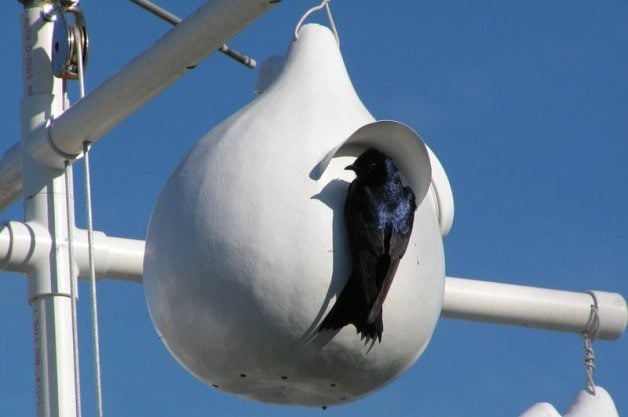
Gourds have been used to make purple martin houses for centuries. Native Americans used to hang them to attract martins to their settlements to help control insects. Today, purple martins east of the Rocky Mountains depend on people to supply them with houses and gourds. Time spent creating a purple martin gourd house is a worthwhile investment. Cured hard-shell gourds are almost as tough as plywood, and they will last up to 30 years if properly coated with a preservative and handled with a little care.
Do purple martins eat mosquitoes? Here’s what you should know.
These basic gourd birdhouses are popular with the birds and purple martin landlords. The best part is, there’s no limit to the number of homemade purple martin gourd houses you can produce and hang right in your yard. We’ve heard of one purple martin enthusiast who puts up and maintains more than 600 gourd houses every year!
Check out more unique birdhouses birds will actually use.
Prepping the Gourd
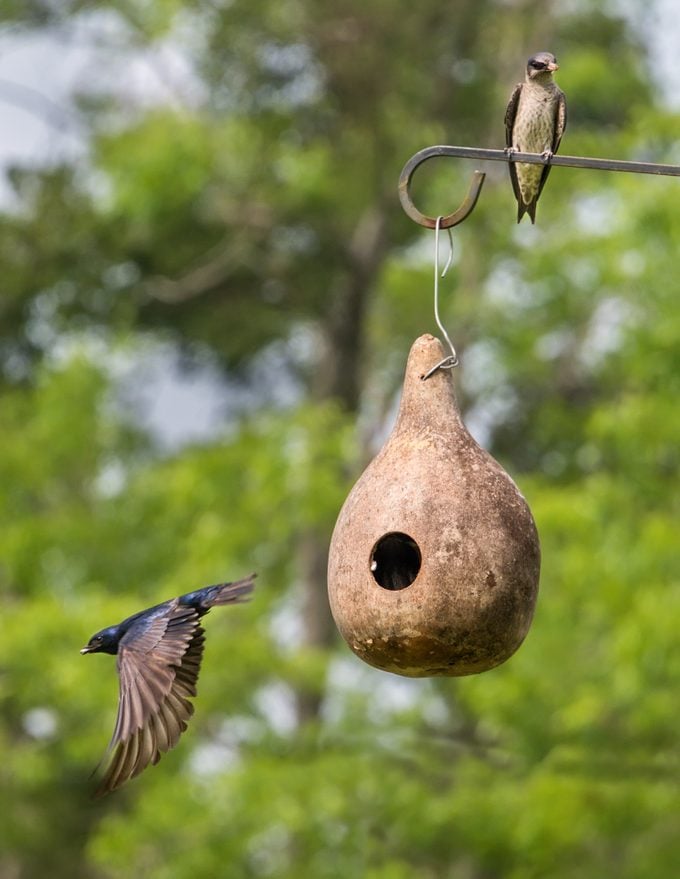
To start, you’ll need one hard-shell gourd, also known as a bottle gourd or birdhouse gourd. Harvest a hard-shell gourd when the vine has withered. Be careful to leave the stem attached. It’s best to cut the stem with pruning shears so you don’t bruise it. A good purple martin gourd has a diameter of about 8 to 13 inches. Wash it thoroughly in water, rinse in a solution of 1 part disinfectant (bleach works fine) and 10 parts water, and dry it with a towel.
Hang the gourd in a sunny spot or place it on newspaper in a warm dry spot (such as an attic or basement) for 3 to 6 months. If the gourd is lying on a flat surface, be sure to frequently turn it. The gourd will begin to mold as it dries—don’t throw it out! This is a natural part of the curing process. Gourds dried indoors will grow the most mold and should be wiped clean frequently with the same concentration (1 to 10) of disinfectant you used for cleaning. However, discard any gourds that become soft or wrinkled.
Check if the gourd is dry by giving it a good shake—if the seeds rattle, it’s time to make a purple martin gourd house!
Learn how to grow pumpkins and gourds.
Materials for a Purple Martin Gourd House:
- One hard-shell gourd, also known as a bottle gourd or birdhouse gourd
- Bleach (for disinfectant)
- Fine steel wool
- Wood preservative or copper sulfate
- Oil-based primer
- Oil-based white enamel paint
- Plastic-coated copper wire, 24 inches long
- Face mask
- Power drill
- 2-1/8-inch hole saw or a keyhole saw
Step-By-Step Instructions:
Step 1
Soak the gourd for 15 minutes in hot soapy water, then scrape it with a dull knife to remove the outer skin and mold. Scrub the gourd in the water with fine steel wool. Rinse it well and allow it to thoroughly dry.
Step 2
To locate the entrance hole, hold the gourd by its stem between your index finger and thumb and let it hang. Mark a center point along the outermost part of the curve so the hole faces straight out—not towards the sky or the ground. The hole should measure 2-1/8 inches and can be easily and quickly drilled with the proper-size hole saw. (Be sure to wear a face mask.) You can also use a keyhole saw to cut the entrance by hand. If you do, it’s best to cut the hole immediately after washing the gourd, while it’s still wet.
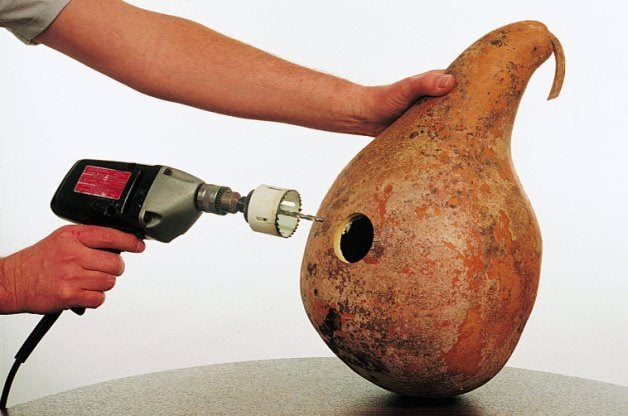
Step 3
Make seven drainage holes in the bottom of the gourd about 2 inches apart using a 5/16-inch drill bit. With the same bit, drill two sets of holes about 2 inches from the top of the gourd’s neck for hanging and ventilation. One set should be drilled perpendicular to the entrance hole and the other in line with it. (You’ll only use one set of holes for hanging. Choose the pair that will allow the entrance hole to face the most open direction.)
Step 4
Remove seeds and membrane through the entrance hole with a long-handled metal spoon, screwdriver or a wire coat hanger (wear a face mask). If this is difficult, soak the gourd in water for several hours. The inside does not have to be completely clean.
Step 5
Dip the gourd in a wood preservative for 15 minutes, weighting it down with a brick. Then remove the gourd and hang it up to dry for several days. (For a cheaper alternative, dissolve 1 pound of copper sulfate (available at garden centers and farm-supply stores) in 5 gallons of warm water and dip the gourd as instructed above. Wear rubber gloves while handling it.)
Tip: Gourds need to be retreated and repainted every few years. So whatever preservative you use, store the solution in a covered plastic bucket for reuse, but keep it away from children and pets.
Step 6
Sand the gourd smooth and paint with an oil-based primer. Allow it to dry. Paint the gourd house with white exterior enamel paint with a nylon brush. (Do not use water-based latex paint because it will peel.) Apply two coats. Be careful not to clog drainage holes.

Step 7
When dry, you can hang your gourd (you’ll need at least 4 to 6 gourds to attract purple martins) from a 24-inch plastic-coated copper wire. Thread the wire through two of the holes directly across from each other and hang it from a support line, below a martin house or on a specially made gourd rack. Hang the gourd 10 to 15 feet high, with the entrance hole facing an open area. The gourd will swing, making it less attractive to nest competitors, such as starlings.
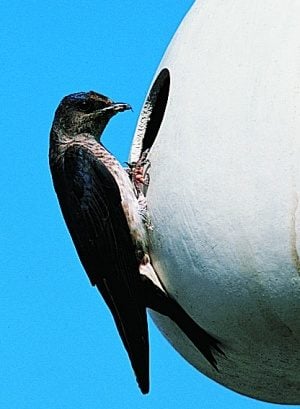
Purple Martin Gourd House Maintenance
In late August or early September, after the martins depart for their winter homes in the tropics, take the gourd house down for cleaning. Break up nests with the handle of a wooden spoon and shake out the contents. Then store until early spring (the martins return as early as February in the deep South) in a spot inaccessible to rodents. Your gourd house will be ready to use again, but you might want to prepare a few more over winter, because the martins will probably bring along a few more friends!
Learn all about swallows nests and nesting habits.
Gourd Birdhouses for Other Birds
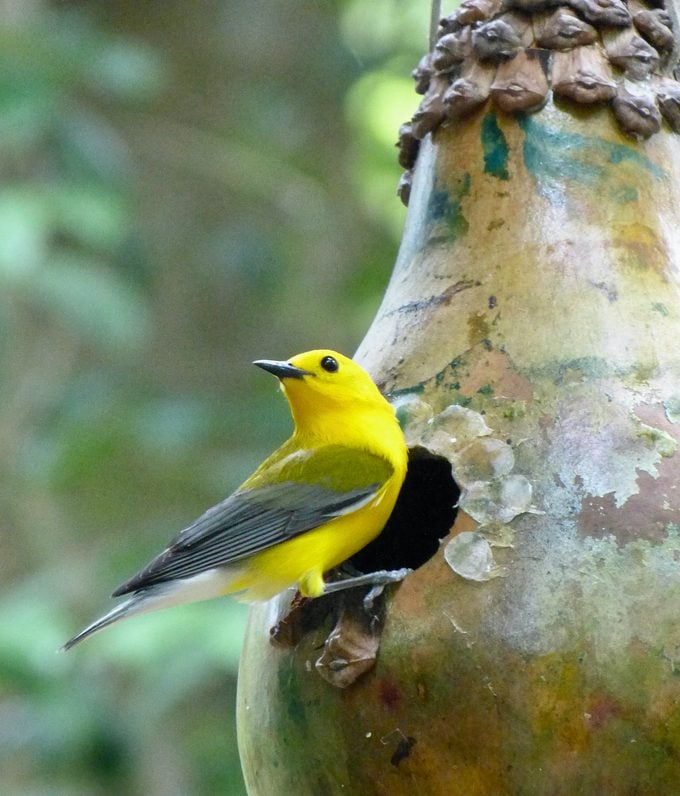
If you live in an area that’s not the most suitable for attracting purple martins, don’t despair. Gourds make fine homes for several varieties of cavity nesters. Some birds you could attract include bluebirds, swallows, chickadees, wrens, woodpeckers, great crested flycatchers, titmice, screech owls, kestrels and nuthatches.
Each bird species has its own requirements for habitat, entrance-hole size and cavity dimensions. For instance, house wrens need a 1-inch entrance hole in a gourd 5 to 6 inches in diameter and prefer gourds hung in a shady area close to brush.
Chickadees need a 1-1/4-inch hole and like to nest in wooded areas. Bluebirds and tree swallows require a 1-1/2-inch hole and prefer to nest in open areas. For flycatchers, make the hole 1-3/4 to 2 inches in diameter and hang the gourd in a tree close to a brushy area.
Next, meet 8 types of swallow birds you should know.